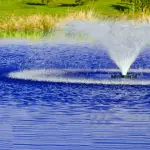Mosquitoes are not only annoying pests but can also carry dangerous diseases. One effective way to control mosquito populations is to target their larvae, which often develop in standing water, such as ponds. In this article, we will explore some eco-friendly methods to get rid of mosquito larvae in a pond.
1. Introduce Mosquito-Eating Fish
One of the most natural ways to control mosquito larvae in a pond is by introducing mosquito-eating fish such as Gambusia or minnows. These fish feed on mosquito larvae, reducing the population significantly. It is essential to ensure that the fish species you choose are native to your area and will not disrupt the pond’s ecosystem.
2. Use Biological Larvicides
Biological larvicides contain bacteria that specifically target mosquito larvae, effectively killing them without harming other aquatic life. Bacillus thuringiensis israelensis (BTI) is a common larvicide used to control mosquito populations in ponds. These larvicides are safe for humans, pets, and other wildlife.
3. Remove Standing Water
One of the most straightforward ways to prevent mosquito larvae from developing in your pond is to eliminate any standing water sources. Mosquitoes lay their eggs in standing water, so by removing these breeding grounds, you can significantly reduce the mosquito population in your pond.
4. Install a Fountain or Aerator
Mosquitoes prefer stagnant water for laying their eggs. By installing a fountain or aerator in your pond, you can create water movement, making it less attractive to mosquitoes for breeding. The movement of water also helps disrupt the development of mosquito larvae.
5. Use Mosquito Dunks
Mosquito dunks are another effective way to control mosquito larvae in a pond. These small, donut-shaped tablets release a bacterium that targets mosquito larvae specifically. Simply place the dunks in the pond, and they will gradually release the larvicide, killing the mosquito larvae.
6. Add Plants
Adding certain aquatic plants to your pond can help naturally control mosquito larvae. Plants like water lilies, water hyacinth, and water lettuce provide shade and cover, making it difficult for mosquitoes to access the water’s surface to lay their eggs. Additionally, these plants can attract beneficial insects that feed on mosquito larvae.
7. Clean the Pond Regularly
Regular maintenance of your pond is crucial for controlling mosquito populations. Remove any debris or organic matter that can accumulate in the pond, as these provide breeding grounds for mosquitoes. Regularly cleaning the pond will help prevent mosquito larvae from developing.
8. Use Natural Predators
Introducing natural predators of mosquito larvae, such as dragonflies and frogs, can help keep the mosquito population in check. These predators feed on mosquito larvae, reducing their numbers naturally. Creating a balanced ecosystem in your pond can help control mosquito populations effectively.

Credit: todayshomeowner.com

Credit: nurturing-nature.co.uk
9. Utilize Mosquito Traps
Mosquito traps are another option for controlling mosquito populations in your pond. These traps use attractants to lure mosquitoes in and then trap them, preventing them from breeding in the pond. There are various types of mosquito traps available, so choose one that best suits your pond environment.
10. Consult with a Professional
If you are struggling to control mosquito larvae in your pond, consider consulting with a professional pest control service. They can assess your pond’s specific conditions and recommend the most effective and safe methods for getting rid of mosquito larvae. A professional can also provide ongoing maintenance to ensure long-term mosquito control.
Conclusion
Controlling mosquito larvae in a pond is essential for reducing mosquito populations and preventing the spread of diseases. By using eco-friendly methods such as introducing mosquito-eating fish, using biological larvicides, and removing standing water, you can effectively get rid of mosquito larvae in your pond. Remember to maintain your pond regularly and create a balanced ecosystem to keep mosquito populations in check.





